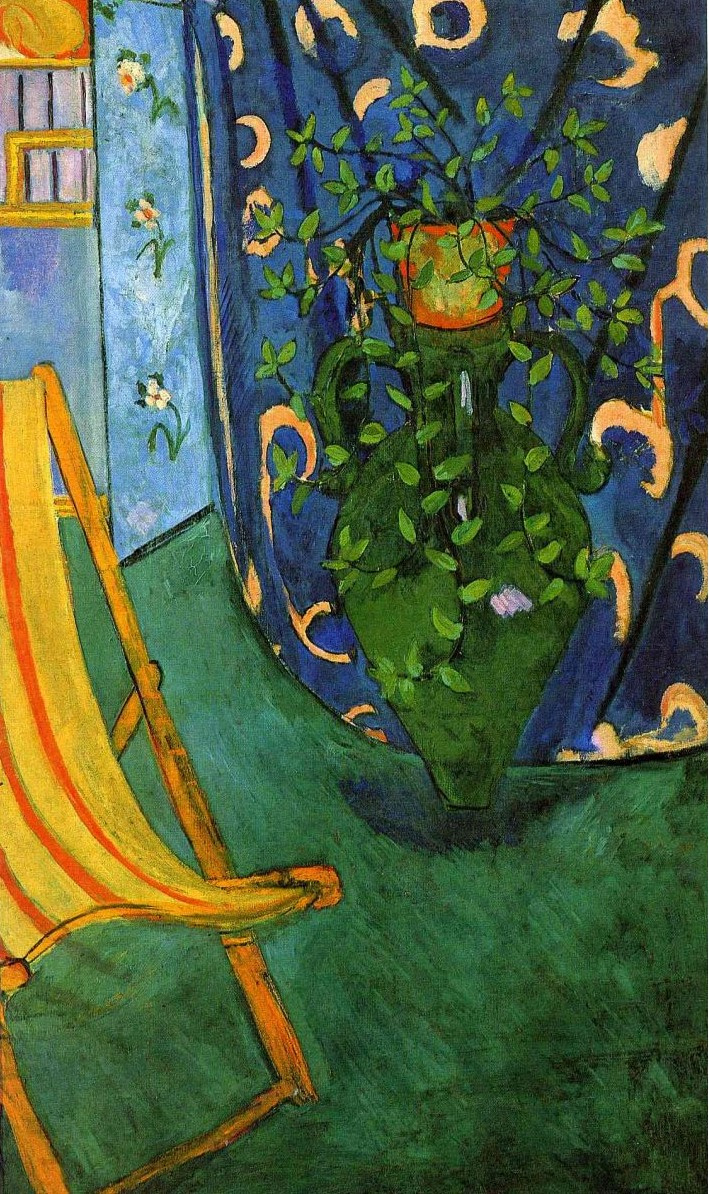log in
Enter site
Login to use Arthive functionality to the maximum
Corner of the Artist's Studio
Henri Matisse • Painting, 1912, 191.5×114 cm
Description of the artwork «Corner of the Artist's Studio»
Matisse painted Corner of the Artist's Studio in 1912, between two trips to Morocco. Just a year earlier, he already painted the things depicted in the painting The Pink Studio, but here he represented a larger fragment of his studio.
As before, Matisse dealt with the real colours of objects and surfaces rather easily, falling for momentary mood and view of the reality at the particular moment. He repainted the pink floor a deep emerald tone, a yellow pattern on the blue fabric became pink, and a screen covered with fabric also matched with an updated colour palette. The picture Le Luxe II remained in the same place, however, now we can only see its lower edge.
In Morocco, Matisse was fascinated by the blue tones and gentler colour spectrum. His living in Tangier and the acquaintance with Islamic culture influenced not only the artist’s choice of a palette but also his manner of painting. The Pink Studio is painted in somewhat careless, sketchy manner, while Corner of the Artist's Studio is far more elaborate. This is evident from the floral pattern on the screen and from the way every leaf in the pot is meticulously drawn.
Not for nothing, the motley screen covered with fabric is central in the painting. Bohain, a place where Matisse was born, is well known for its weavers making sophisticated fabrics. They produced silk and brocade, velvet and cashmere, French tweed and transparent tulle. As a child, Matisse liked to observe the work of weavers, the way they achieved subtle shades combining them into patterns on their machines, like artists at their easels.
Later, during his studies in Paris, he spent all his money buying tiny patches of fabric from the old clothes-men; hey were pieces of antique tapestries and embroideries for his museum of fabric. Much later he would have the privilege to paint models in luxurious dresses from the most popular fashion houses. Those dresses would be made of fabric produced by the masters of his native town. And he often took a keen interest in those fabrics and patterns, outshining the traits of models; the picture Zorah on the Terrace can serve as an example of this.
In July 1912, the art collector Shchukin purchased Matisse’s painting Corner of the Artist's Studio along with other four canvases. He hung three of them in the dining room: The corner was on the right, The Conversation – in the centre, and Nasturtiums – on the left; together they created an effect of one huge colourful panel.
Author: Natalia Azarenko
As before, Matisse dealt with the real colours of objects and surfaces rather easily, falling for momentary mood and view of the reality at the particular moment. He repainted the pink floor a deep emerald tone, a yellow pattern on the blue fabric became pink, and a screen covered with fabric also matched with an updated colour palette. The picture Le Luxe II remained in the same place, however, now we can only see its lower edge.
In Morocco, Matisse was fascinated by the blue tones and gentler colour spectrum. His living in Tangier and the acquaintance with Islamic culture influenced not only the artist’s choice of a palette but also his manner of painting. The Pink Studio is painted in somewhat careless, sketchy manner, while Corner of the Artist's Studio is far more elaborate. This is evident from the floral pattern on the screen and from the way every leaf in the pot is meticulously drawn.
Not for nothing, the motley screen covered with fabric is central in the painting. Bohain, a place where Matisse was born, is well known for its weavers making sophisticated fabrics. They produced silk and brocade, velvet and cashmere, French tweed and transparent tulle. As a child, Matisse liked to observe the work of weavers, the way they achieved subtle shades combining them into patterns on their machines, like artists at their easels.
Later, during his studies in Paris, he spent all his money buying tiny patches of fabric from the old clothes-men; hey were pieces of antique tapestries and embroideries for his museum of fabric. Much later he would have the privilege to paint models in luxurious dresses from the most popular fashion houses. Those dresses would be made of fabric produced by the masters of his native town. And he often took a keen interest in those fabrics and patterns, outshining the traits of models; the picture Zorah on the Terrace can serve as an example of this.
In July 1912, the art collector Shchukin purchased Matisse’s painting Corner of the Artist's Studio along with other four canvases. He hung three of them in the dining room: The corner was on the right, The Conversation – in the centre, and Nasturtiums – on the left; together they created an effect of one huge colourful panel.
Author: Natalia Azarenko


